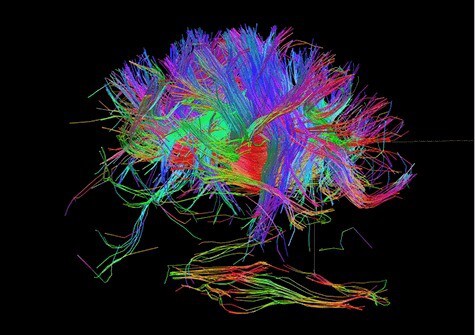The way our brains are wired may reveal a lot about us, according to new research co-authored by scientists at Washington University in St. Louis.
For example, people with “positive” behavioral traits, such as sharp memories, many years of education and robust physical endurance, have stronger neural connections between certain brain regions than people with “negative” traits, such as smoking, aggressive behavior and a family history of alcohol abuse.
The study, published recently in the journal Nature Neuroscience, is among the first fruits of the Human Connectome Project (HCP), a $40 million brain imaging initiative funded by the National Institutes of Health (NIH). The project is led by scientists at Washington University, University of Minnesota and Oxford University in the United Kingdom.
Describing the findings as “impressive,” Washington University School of Medicine in St. Louis neuroscientist Marcus E. Raichle, MD, told Nature News that the research confirms it’s possible to “distinguish people with successful traits and successful lives from those who are not so successful” based in part on the activity and anatomy of their brains.
Led by a team at Oxford University’s Centre for Functional MRI of the Brain, the study was co-authored by Washington University’s Deanna Barch, PhD, professor and chair of the Department of Psychological and Brain Sciences in Arts & Sciences, as well as a professor of psychiatry and of radiology in the School of Medicine; and David Van Essen, PhD, the Alumni Endowed Professor in the Department of Anatomy and Neurobiology.
The HCP brings together a global consortium of researchers working to map the structural and functional connections of the healthy, living human brain. Designed to study how brain connectivity relates to individuals’ skills and behavior, the project will provide researchers with detailed, high-resolution MRI brain scans on 1,200 volunteers.
The new study, based on data from the first 500 volunteers scanned as part of the HCP, looked closely at a series of brain regions involved in high-level cognition, like memory and imagination, including a network that remains active when the brain is relatively idle.
Earlier research by Raichle, the Alan A. and Edith L. Wolff Distinguished Professor of Medicine, played a pivotal role in the discovery of brain regions now known as the “default mode network.” These regions become active when the brain seemingly is at rest and not actively engaged in a task.
For the new study, the researchers examined a HCP database that included resting-state connectomes from about 460 people ages 22 to 35 years, and information about 280 different behavioral and demographic traits that were recorded for these same participants.
“The quality of the imaging data is really unprecedented,” said Steven Smith, PhD, a biomedical engineer at the University of Oxford and lead author of the study. “Not only is the number of subjects we get to study large, but the spatial and temporal resolution of the fMRI data is way ahead of previous large datasets.”
As detailed in an Oxford University news release, Smith and his colleagues ran a massive computer analysis to examine how brain connectivity patterns correlated with individual behavioral traits, such as age, socioeconomic status, history of drug abuse, personality traits and various measures of intelligence.
The study found that participants with strongly connected brain networks also scored high on behavioral measures usually considered to be positive, such as a large vocabulary, good memory, life satisfaction, income and years of education. Conversely, those with weaker network connections were found to exhibit high scores for traits typically considered negative, such as anger, rule-breaking, substance use and poor sleep quality.
“This study provides intriguing insights into how behavior is related to the incredibly complex brain networks that make each of us a unique individual,” said Van Essen, who is a principal investigator of the HCP. “It is also a testament to the intense efforts by the HCP team to improve the methods of imaging data acquisition and analysis.”
Some of these advances were contributed by Matthew Glasser, a graduate student in Van Essen’s lab and a co-author on the study.
In an interview with Nature News, Raichle cautioned that the findings of this study do not establish a cause-and-effect relationship between strong brain network connections and positive behavioral traits or between weak connections and negative traits.
While the brain connection patterns are clear across the 461 volunteers in this study, there’s a lot of work that needs to be done before brain scans could be used to predict what sorts of skills or behavior we might expect from a particular individual.
Once these causal relationships are better understood, it could be possible to push brains toward the “good” end of the axis, Barch told Nature News.
Barch said that it is likely that the variation in brain connectivity and traits seen across individuals reflects a complex dance between environment and biology. Understanding the precise nature of these causal influences will help lead to the design of better interventions to help move the brain and behavior toward the positive end of the spectrum.
The HCP consortium includes more than 100 investigators and technical staff at 10 institutions in the United States and Europe. It is funded by 16 components of the NIH via the Blueprint for Neuroscience Research.
If our reporting has informed or inspired you, please consider making a donation. Every contribution, no matter the size, empowers us to continue delivering accurate, engaging, and trustworthy science and medical news. Independent journalism requires time, effort, and resources—your support ensures we can keep uncovering the stories that matter most to you.
Join us in making knowledge accessible and impactful. Thank you for standing with us!

